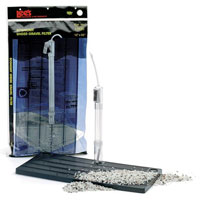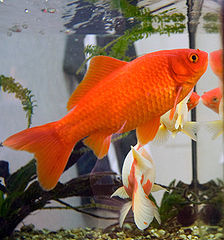Although goldfish made their debut as pets over 2,000 years ago, their needs are not always understood by those new to fish-keeping. Because the average pet store goldfish is small and inexpensive, they are sometimes viewed as “beginner’s pets” that need little care. Add to this the fact that many people remember “Grandma’s goldfish that lived for years in a tiny bowl”, and it’s easy to see why most meet untimely ends (well-cared for goldfishes can live into their 20’s – and sometimes to twice that age!). Folks who buy a single goldfish usually do not want to be bothered with a filter, but the lack of filtration is by far the main reason for failure with these otherwise hardy fishes. However, there is a filter that needs no pad or carbon changes, and which becomes more effective with age – custom made for busy, “filter-shy” fish enthusiasts. Today we’ll take a look at it and other simple options that will lessen your workload and improve your goldfish’s quality of life.
Goldfish Do Not Stay Small!
When considering a goldfish, it’s important to realize the potential size your pet will reach. Goldfish are available in a wide variety of colors, 4 tail-shapes, 3 body-shapes and 3 eye-types, but are all of the same species, Carassius auratus auratus. Those known as comets – the basic pet store or “non-fancy” goldfish – can easily reach 8-12 inches in length. Sixteen-inch long individuals have been recorded; in fact, I have seen several feral goldfishes near that size in the Bronx River, mixed in with breeding aggregations of carp (I must check if hybridization is possible…). Fantails, moors and other strains tend to be shorter in length than comets, but they get quite hefty.
True, improperly-kept goldfishes will become stunted, and may survive in that state for several years, but this is not to be encouraged – and certainly not a lesson to be teaching the children for whom single goldfishes are often purchased. When fully-grown, your pet will need a 20 gallon aquarium in which to live; plan on a 30 gallon for a pair.
The Ultimate Goldfish Filter
Although now largely-ignored by hobbyists, (perhaps they are “too simple”!), undergravel filters were once considered indispensable by serious aquarists, and are still relied-upon by many public aquariums today. In zoos and at home, I’ve used these highly-effective filters in aquariums housing creatures ranging from seahorses to alligator snapping turtles, always with great results.
 When considering undergravel filters, it’s important to bear in mind that biological filtration – the breakdown (by aerobic bacteria) of ammonia to nitrites and nitrates – is the most important function of a filter (please see article below). And it is at this aspect of filtration that undergravels excel. Simply-put, an undergravel filter turns your aquarium’s substrate into a giant, living, biological filtration unit. What’s more, the filter plate does not take up important living space and, being hidden below the gravel, allows for the creation of pleasing aquascapes. Best of all, there are no cartridges or filter mediums to clean or replace!
When considering undergravel filters, it’s important to bear in mind that biological filtration – the breakdown (by aerobic bacteria) of ammonia to nitrites and nitrates – is the most important function of a filter (please see article below). And it is at this aspect of filtration that undergravels excel. Simply-put, an undergravel filter turns your aquarium’s substrate into a giant, living, biological filtration unit. What’s more, the filter plate does not take up important living space and, being hidden below the gravel, allows for the creation of pleasing aquascapes. Best of all, there are no cartridges or filter mediums to clean or replace!
Water Changes
Regular partial water changes are essential to maintaining water quality and fish health…regardless of tank size, filtration method, or fish species. When doing partial water changes, be sure to use a manual or battery-operated gravel washer. In this way, you will remove debris trapped in the substrate along with the water…that’s all the maintenance your undergravel filter will need!
Currents
Undergravel filters have another characteristic that suits them well for use with goldfish. Goldfish evolved in slow-moving waters, and they cannot abide fast currents; fantails, lionheads and other round-bellied varieties are especially-weak swimmers. Yet they produce a good deal of waste, and do best in aquariums equipped with powerful filters (which usually put out strong outflow currents). Undergravel filters discharge clean water through two tubes that reach to the water’s surface…even when very powerful air pumps are used, outflow currents remain mild. You can check out a wide variety of air pump styles and sizes here; please post below if you need assistance in choosing a pump.
Increasing Your Filter’s Efficiency
Power heads can be used in place of air pumps if you need to increase water flow through the gravel bed. You can also set up a reverse-flow system, which will lessen the amount of detritus that becomes trapped in the substrate; please post below for details.
Commercially-available aerobic bacteria (i.e. Nutrafin Cycle) can be used to jump-start your filter or to boost the beneficial bacteria populations that have developed naturally.
Other Goldfish Filters
From simple corner filters to state-of-the art canisters, there is a huge array of other filtering options for goldfish owners. Please share your thoughts and experiences by posting below.
Further Reading
 That Fish Blog – Aquarium Advice and Information
That Fish Blog – Aquarium Advice and Information







